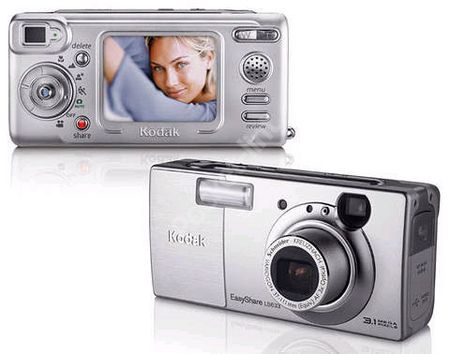While a lot of people will believe that every three mega pixel camera looks the same every so often along comes a camera that is slightly different. Perhaps it’s a different shape or maybe has a facility to make cups of tea.
Our quick take
Saving pictures to the internal memory isn’t the fastest thing you’ve seen and beyond the large screen on the back this camera offers little more than every one else on the market at this range. The trouble is, is that everyone else at this level is some £20 or more cheaper and for another £50 you could get the more stylish looking Mju Digital or Pentax Optio S, and while they don’t offer a screen anywhere as big the they are considerably smaller and more stylish in design. The question with this camera is whether you mind paying the extra for the large screen? Everything is easy to use, menus are clear and the picture quality is good - similar to that of the DX6440, but then even that is £50 cheaper and sports a bigger optical lens. Without wanting to sound rude, this camera is great for people who wear reading glasses, but don’t want to have to put them on to seeing what they are doing when taking a picture.

Kodak EasyShare LS633 - 3.5 / 5
| FOR | AGAINST |
|---|---|
|
|
Kodak’s latest camera, the LS633 boasts a 2.2” OLED screen on the back, making this not only one of the largest screens around, but also due to its manufacturing process one of the clearest. Based on a Kodak’s new Organic Light emitting diode (OLED) technology, you can see the display clearly from virtually any angle (165o viewing angle to be precise) and even on bright sunny days it didn’t seem to cause us any problems.
Due to the large screen the camera is longer than most digital cameras available on the market but Kodak users looking to upgrade still pleased to know that it will still fit the both the Camera and Printer Dock 6000 range.
Buttons are in the usual familiar Kodak spots and the share button allowing you to set printing, emailing and favourite option up in advance before docking your camera and while everything has been put comfortably in the right places, there doesn’t seem to have been any effort to make the camera look anything other than the square box that it is.
Images are transferred from the camera’s 16Mb internal memory or SD/MMC card either by a USB connector or investing in either a docking station or printer and the whole device is powered by a Kodak rechargeable Li-ion battery - a nice touch for a sub £300 camera.
The LS633 offers a 3x optical zoom and 3.3x digital zoom giving you a range of 37 - 111mm on a standard 35mm camera with a f range of 2.7 - 4.6. Images are saved in four different sizes; 2032 x 1524, 2032 x 1354, 1656 x 1242, 1200 x 900 and gives you 16, 18, 25 and 47 images respectively.
Like other cameras in the Kodak EasyShare range, there are a number of pre-programmed settings to choose from and these include Night Scene, Landscape, Sport, Macro and Movie. In addition to that the camera also has 4 white balance settings, four flash settings, the ability to set the ISO level from 100, 200 and 400 and three different focusing protocols including Multi-pattern and Centre weighted TTL-AE with individual program modes.
Picture quality was either poor or brilliant when it came to taking pictures. The whites unlike the DX6430 didn't cause a problem within the images, yet images did lack definition and at time crispness. Colours however were generally strong within the images (see red posts right) but vast expanses of green caused the sensor to treat them as one (see landscape image right).
To recap
£50 more could buy you a Mju Digital or Pentax Optio S which you could learn in time, relegating the LS633 to unsteady learners only.
